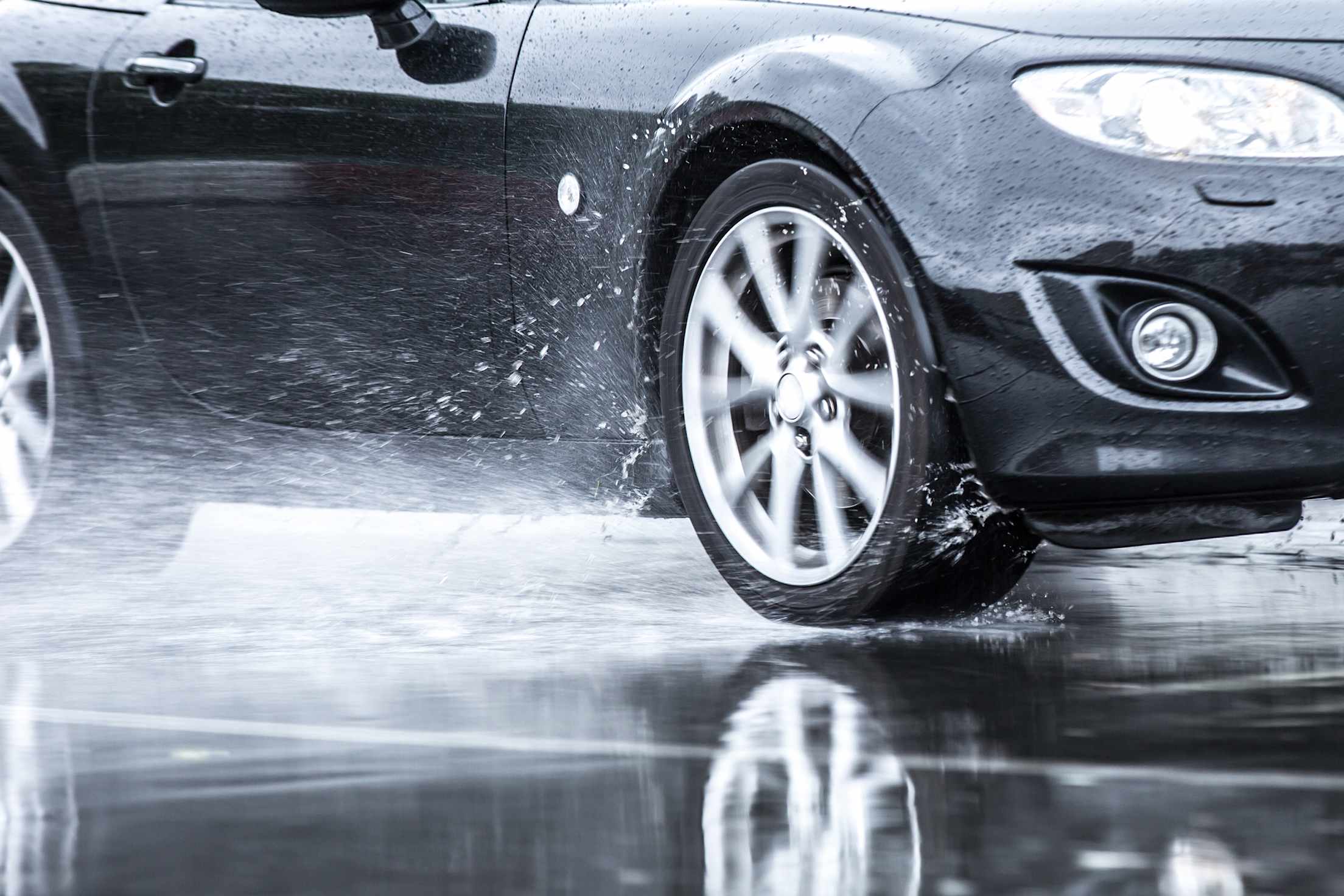
How to Safely Drive in the Rain
Follow these 10 tips to stay calm and safe while traveling in wet weather.

Singing in the rain has sweet associations, but driving in the rain? Not so much. One in five motor vehicle crashes nationwide occurs in adverse weather or on slick pavement. When the roads are wet, we all need to exercise extra caution—and some specialized skills—behind the wheel. Get yourself ready for the rainy season with these safety tips.
1. Assess your situation.
Consider your driving skills and be honest with yourself about your limitations. Are you nervous about driving in wet weather? How is your eyesight in dark, rainy conditions? If you feel uneasy, change your plans. Very few trips are so important that you can’t modify or postpone them. When you do drive, wear comfortable clothing. Remove bulky rain gear or clunky shoes that might restrict your movements or hamper your ability to respond to varying conditions and situations.
2. Drive defensively.
Rainy conditions can make it difficult to see and hard to maneuver. In low visibility, with less traction, give yourself extra time to react. The first rains of the season or after a dry spell can be especially hazardous, as lingering oil and debris make the road slick before subsequent storms wash them away.
On wet roads, tires lose about a third of their traction. Adjust accordingly by reducing your speed by one-third below your normal safe driving speed, says William Van Tassel, AAA manager of Driver Training Programs. Don’t use cruise control as it can make hydroplaning and skidding worse by trying to keep your vehicle at a constant speed. In slick conditions, manually control your speed and avoid sudden starts and stops.
In dry conditions, AAA recommends staying 3 to 4 seconds behind the car in front of you. To calculate this, pick a landmark in the distance. When the car ahead of you passes it, start counting. If you reach that same landmark in less than 3 seconds, you are following too closely behind. In poor conditions, increase that time by one second for every negative environmental factor. “So, if it’s rainy, add one second,” Van Tassel says. “If it’s rainy and dark, add two seconds.”
It might feel like you’re driving too slowly and leaving excessive room between you and other cars. You’re not. “Remember,” Van Tassel says, “anytime you’re driving, space is your friend. If there’s nothing around you, you can’t collide with anything.”
3. Pay attention.
Distracted driving is especially dangerous in the rain, when visibility decreases and stopping times increase. Don’t use your phone or eat while driving, regardless of the weather conditions, and avoid fiddling with the radio.
4. Watch out for water hazards.
Good tire traction happens when the rubber meets the road. But in rainy conditions, water often gets in the way. To protect your vehicle’s grip on the pavement, avoid driving through standing water whenever possible. Puddles and flooded areas are often deeper than they appear and can cause you to get stuck or lose control of your vehicle.
If you’re driving on a single-lane road, Van Tassel says, do your best to stick to the driest portion of the lane. “Lanes are generally 12 feet wide,” he says, “and all of that 12 feet is yours to use,” provided you can do so safely (keep an eye out for cyclists and pedestrians when close to the right side). On multi-lane roads, Van Tassel says it’s often preferable to drive in the right lane, as it’s easier to pull onto the shoulder if needed.
Driving in the tire-trail of the car ahead of you is often a good option, as those tires displace water, leaving you with better traction. “Just be sure you aren’t tailgating,” Van Tassel says.
5. Steer clear of collisions.
Although driving defensively will minimize your risks, you still might find yourself in a situation that calls for evasive action. At speeds of 25 miles per hour and faster, steering around an obstacle is preferable to braking, because sudden braking on wet roads can lead to hydroplaning.
Regardless of the weather and road conditions, you should not have to move your hands on the steering wheel during a single emergency maneuver according to Van Tassel. By holding the wheel with both hands at the 9 o’clock and 3 o’clock positions, you should be able to turn the steering wheel up to 180 degrees to avoid an object directly ahead, without taking your hands off the wheel. This is what is known as “fixed-hand” steering, and it’s what AAA recommends for emergency avoidance maneuvers.
6. Know how to respond to hydroplaning.
Hydroplaning occurs when your vehicle’s tires lift off the pavement onto water, which causes the vehicle to slide. This can happen with as little as 1/12-inch of water on the road. Without any traction, you may lose control of your vehicle. If you feel the car begin to hydroplane or fishtail, continue to look and steer in the direction you want the car to go. Try not to panic, and avoid hitting the brakes, which can intensify the problem and send your vehicle further out of control.

Proper tire tread is essential to maintain traction on wet roads.
7. Slow down safely.
“We like to train people to control their velocity with the accelerator,” Van Tassel says. That’s because it’s generally safer to ease off the gas pedal than it is to slam on the brakes, and it requires you to look further ahead and stay focused on the task at hand, which are vital for safe driving in any weather. If you drive slowly enough and pay keen attention to what’s happening around you, you can often avoid relying heavily on your brakes. “By lifting your foot off the accelerator, you not only slow down, you also put your foot in a better position to use the brake if you absolutely need to,” he says.
Most vehicles today have antilock brakes, but if you don’t have them, avoid slamming on your brakes which can lock the wheels and increase the risk of hydroplaning and fishtailing. Instead, pump the brakes lightly to slow down. With anti-lock brakes, you can firmly press on the brakes and use what is known as the plant-and-steer method. This method allows you to steer while braking. That’s what antilock brakes are for. “They’re not designed to make you brake faster,” Van Tassel says. “They’re designed to let you brake and control the vehicle at the same time.”
8. Change lanes only when necessary.
On wet roads, do your best to avoid changing lanes. But if conditions require you to move over—maybe your lane is flooded, you’re being tailgated, or you don't feel comfortable with the traffic flow—do it as cautiously as you can. Signal with your blinker, check your rear- and side-view mirrors to make sure the path is clear, and execute the lane change carefully.
9. Increase visibility.
Most states require that headlights be kept on in low-visibility conditions, and in California, anytime your windshield wipers are on continuously, headlights are required by law to be on as well. But no matter the conditions, it’s always a good idea to have your low-beams on, according to Van Tassel. “They don’t just help you see,” he says. “They also help you be seen.”
In cold and wet conditions, turn on your windshield defroster with the A/C on to remove moisture from the air and prevent your windows from fogging. When it’s foggy outside, use your low beams. High beams in fog are counterproductive, as the light bounces off beads of moisture and produces glare that reduces your own visibility.
10. Adjust accordingly.
When temperatures drop, other hazards can arise, including ice, rain, fog, and snow. In these conditions, many of the same recommendations for driving in the rain apply. See this detailed video from AAA for more information about safely driving in winter weather.
“There are so many different scenarios you can encounter,” Van Tassel says. “But so much of this comes back to driving slowly and staying aware.”
Get peace of mind on the road with AAA Membership and its legendary roadside assistance.